
Wymbolwood Beach, Ontario
Background
Meeting the challenge of managing on a small scale without herbicide
GLPC Editor’s Note: This case study showcases small-scale management that does not require herbicide. Due to the size of this project, not all protocols detailed in the case study are comprehensive. This model is most applicable for private landowners or small parcels where continuous monitoring and follow up treatments are possible.
Author: Lynn Short
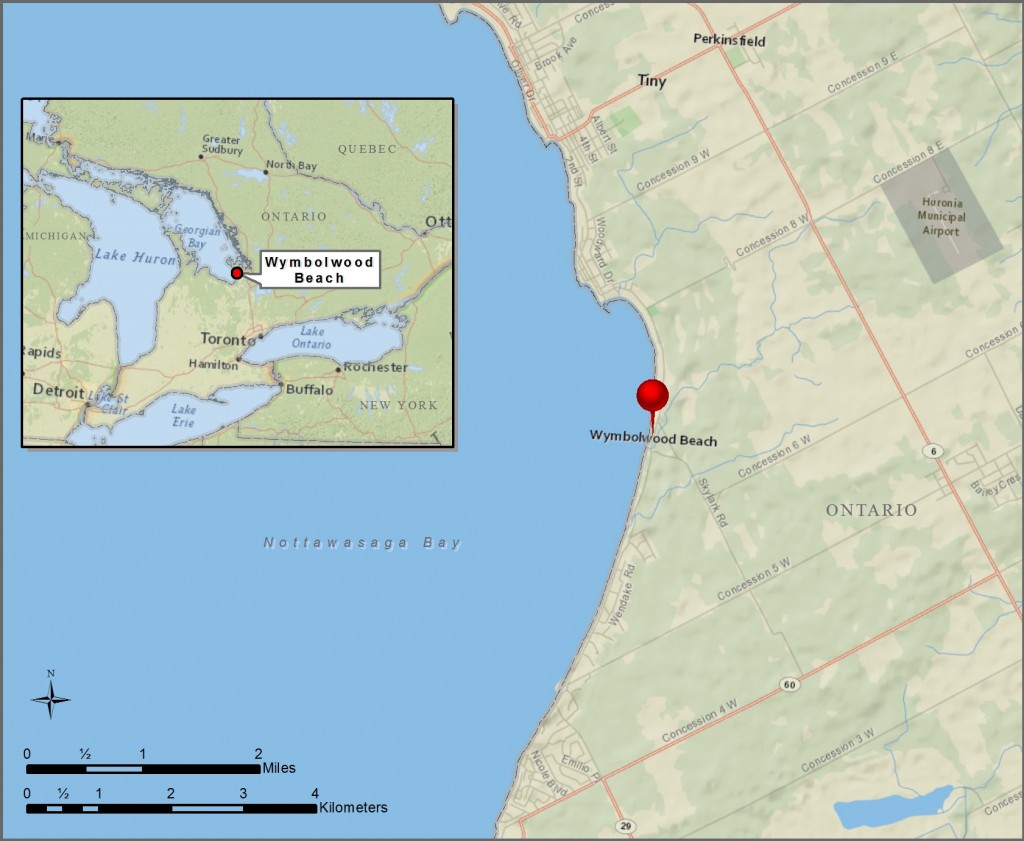
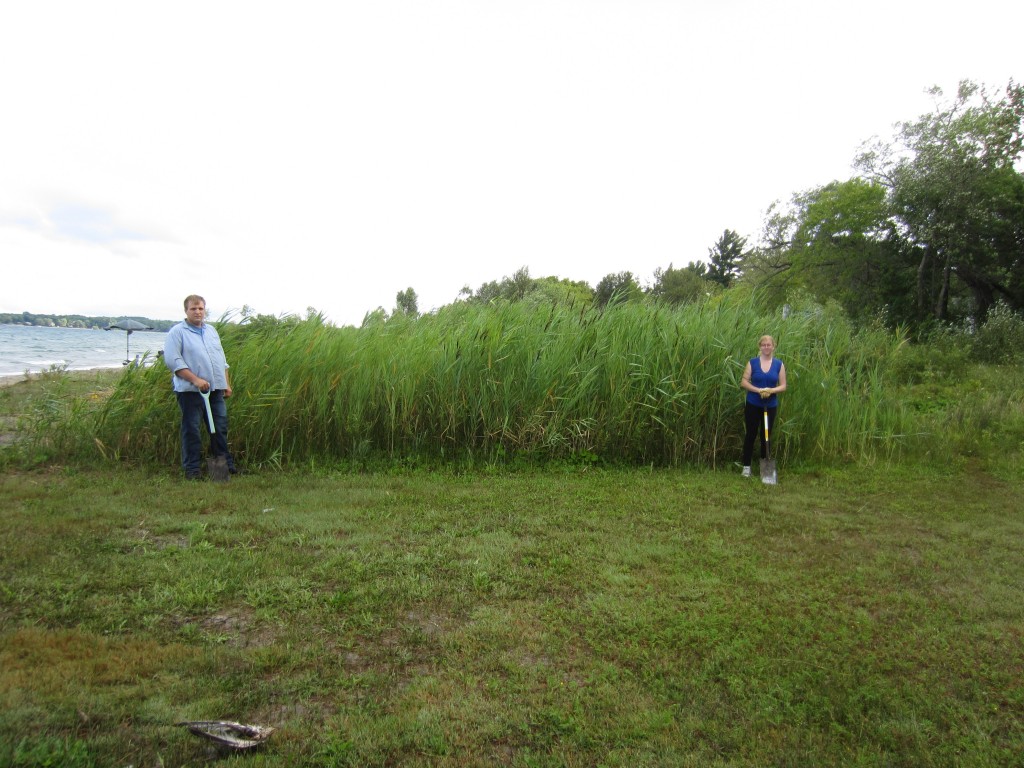
Non-Native Phragmites along Wymbolwood Beach. Image courtesy of WBA.
Wymbolwood Beach, Ontario is part of Nottawasaga Bay in the eastern basin of Lake Huron, and includes approximately 3km (1.9 miles) of sandy beach bordered by trees. Most of the properties along the shore are privately owned, approximately 15-30 meters (50-100 feet) wide, with some Township access points interspersed. Though the Wymbolwood Beach Association (WBA) is primarily a community social group, spurred on by an individual member in 2000, members of the association began a response to the growing non-native Phragmites population taking over beachfront properties in their area.
Through the WBA, area residents have been encouraged to control non-native Phragmites on their own properties. By 2015, areas of repeated removal showed mixed vegetation while unmanaged areas had near monoculture stands of non-native Phragmites. For most of this time, management has been conducted by individual landowners, but in 2010, the group initiated a student work program, hiring local area high-school students to assist with management activities.
Partnerships and Administration
The WBA does not have formal authority over the beach, but provides an avenue for members to connect. One resident serves as the volunteer program coordinator for the non-native Phragmites student work program. The coordinator trains and supervises the students, gains verbal permission from the students’ parents and the landowners requesting work, and coordinates scheduling with the students and landowners. The coordinator also advertises the program by writing an article for the WBA’s annual publication to both encourage residents to manage non-native Phragmites on their own properties, and to invite high-school students to participate in the summer work program.
Individual property owners, unable to manage non-native Phragmites on their own, are able to directly pay students $12/hour CAD for management to be conducted on their property. The cost per resident depends on the size of the property and the amount of Phragmites present. The initial cost for removal on a 75 foot wide lot might be between $300 and $500 CAD. This cost is usually reduced to $100 to $200 CAD over a couple of years and eventually most residents take the job over. Student participants benefit from this program by securing summer jobs, typically three-hours/day, and learning about beach ecology, biodiversity, and ecosystem management, while also providing a valuable service to area residents. The students also model good management practices for neighbors in the area, and help build community ties around the issue. Because many of the property owners are seasonal residents, it can be challenging to engage enough students to handle the task.
One initial challenge of the project involved securing enough tools for the student teams. The WBA and several residents funded the purchase of additional tools, which, combined with those brought by the students and the project coordinator, have been sufficient.
Not all area residents manage the non-native Phragmites on their properties, and the Township does not control non-native Phragmites at their beach access points.
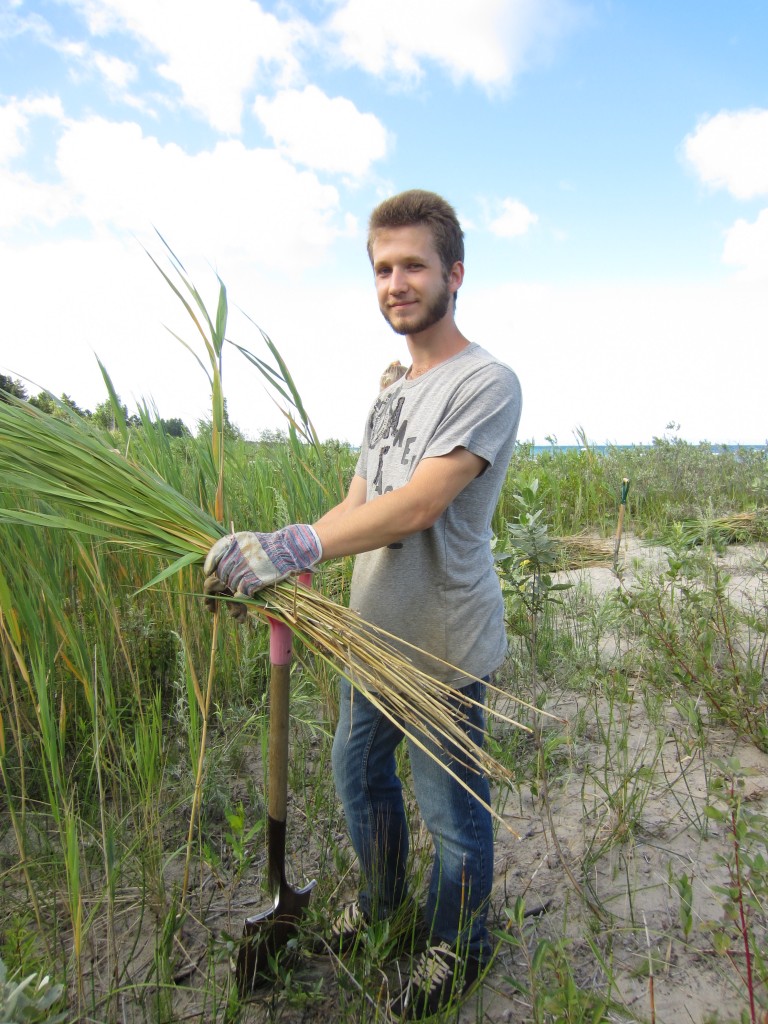
A student selectively removing invasive Phragmites along Wymbolwood Beach. Image courtesy of WBA.
Management Objectives
Two primary objectives surfaced for Wymbolwood Beach residents: maintaining biodiversity and the recreational and aesthetic functions of the beach. Wymbolwood Beach residents noticed a loss of native plants, including flowering plants valued by the community, and a reduction in the presence of frogs and toads. In addition, large infestations were blocking views and access to the beach. The beach and shore areas are primarily used for walking, swimming, kite surfing, kayaking, canoeing, and paddle boarding; all activities potentially impacted by large monoculture stands of non-native Phragmites.
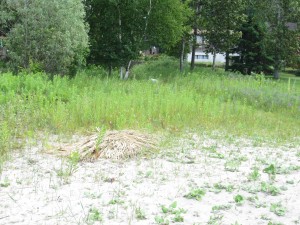
After a selective removal of non-native Phragmites along Wymbolwood Beach, evening primrose is the dominant species on this property. Image courtesy of WBA.
Prioritization
Sites within the area are not prioritized, but are managed based on the willingness of the property owner. Property owners can do the work themselves or hire students from the program. Properties that have had students working on them in past years are prioritized to receive help because the best control is achieved with repeated removal. For new properties, if treatment is not possible in the current year, every effort is made to work on the property the next year. Adult volunteers also offer to help cut off the inflorescences (flowers) in the current year to prevent spread of the seeds.
Policy and Regulations
Because work is conducted on private properties and no herbicide or heavy equipment is used, no permits are required. Agreements with landowners to conduct work and pay students are made verbally.
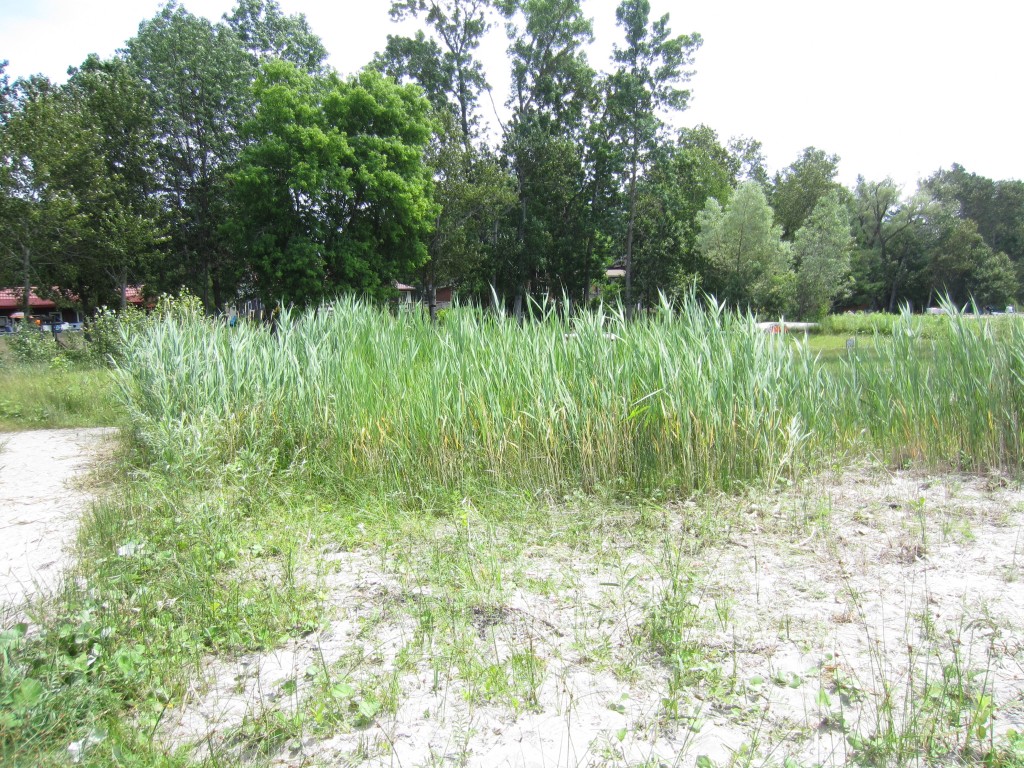
Non-native Phragmites in the process of being removed along the Wymbolwood Beach. The area in the foreground was recently treated. Image courtesy of WBA.
Communication and Outreach
In addition to teaching the student workers about non-native Phragmites, biodiversity, specific species present at the beaches, and proper management techniques, the program coordinator conducts outreach to community members. The coordinator writes articles for the WBA annual publication to inform residents about the problems caused by non-native Phragmites and possible solutions. The coordinator also gives a presentation at the WBA Annual General Meeting each September, and conducts direct outreach to people along the beachfront to encourage more widespread management and the use of selective management instead of whole-beach ploughing conducted by some property owners.
Residents walking past work sites are able to see the techniques used and speak to the team. The students serve as ambassadors and are able to educate others and model good management practices.
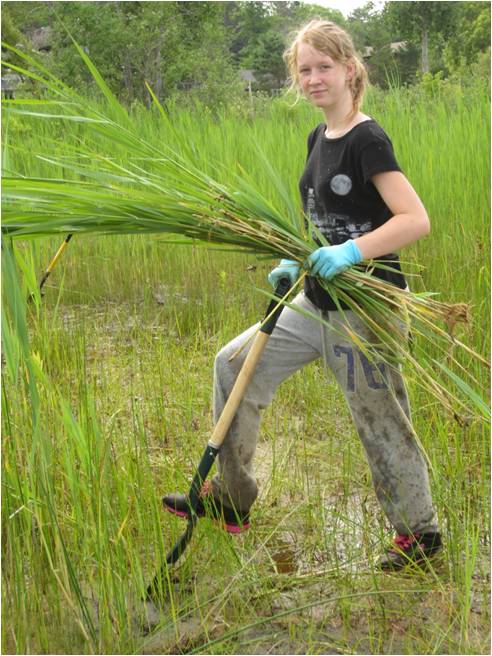
An example of a student who serves as an ambassador for the Phragmites removal program. Photo courtesy of WBA.
Management
In Ontario, herbicide use is not permitted for use along the shoreline so non-native Phragmites is removed manually. From mid-July to mid-August, workers use a spade to cut individual stalks of non-native Phragmites 3-5cm (1-2in) below the soil surface. Completing work in August ensures the plants have not yet gone to seed. Removing the top of the plant below the soil surface forces the plant to use energy reserves from the root system without the benefit of photosynthesis, ultimately weakening the clone. Each property on the beach is 50, 75 or 100 feet wide and the distance between the tree line and the water is approximately 50 feet. Non-native Phragmites is selectively removed in these areas while minimizing the disturbance to surrounding soil and native plants. Plants that are removed are dried and burned or taken to the local composting facility.
This method is labour intensive and requires a longer timeframe than herbicide treatments, but persistent, selective removal of the stalks has been shown to control the non-native Phragmites within 4 -5 years on Wymbolwood Beach. In the five years since treatment began, some of the worst properties are now only 1/3 to 1/2 Phragmites but the stalks are dispersed among the native shrub willows and wildflowers. On all controlled properties, the plant is no longer present in monoculture stands, the stalks are interspersed within the native species. For many properties, non-native Phragmites is almost completely gone, with just a few small plants that reappear each spring. As management continues, the native species continue to re-colonize.
No heavy equipment or special chemicals are required for this management, so it is accessible to residents and easy to conduct with little preparation. While some residents plough their beach to remove the non-native Phragmites, that method is not preferred because it does not support native plant populations and maintains a continuously disturbed site, perfect for new invasions.
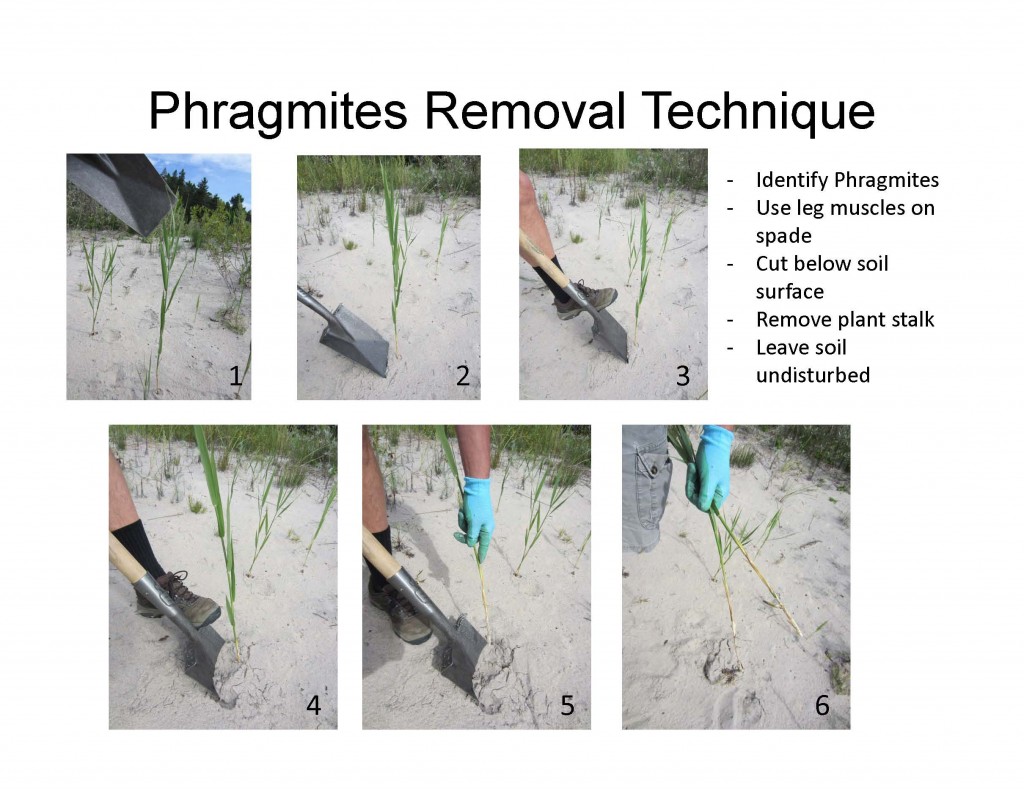
Because herbicides are not permitted for use over water in Canada, WBA has created a manual treatment technique. Image courtesy of WBA.
Monitoring
Non-formal visual inspections are conducted each year to assess the non-native Phragmites populations. Residents informally report the return of frogs and wildflowers to the program coordinator.
Data and Information Integration
No formal data is maintained for this project. Casual observations provide enough motivation for many residents to embrace the program, though a more formal system could possibly help non-residents or skeptical residents see the benefits of the program more clearly.
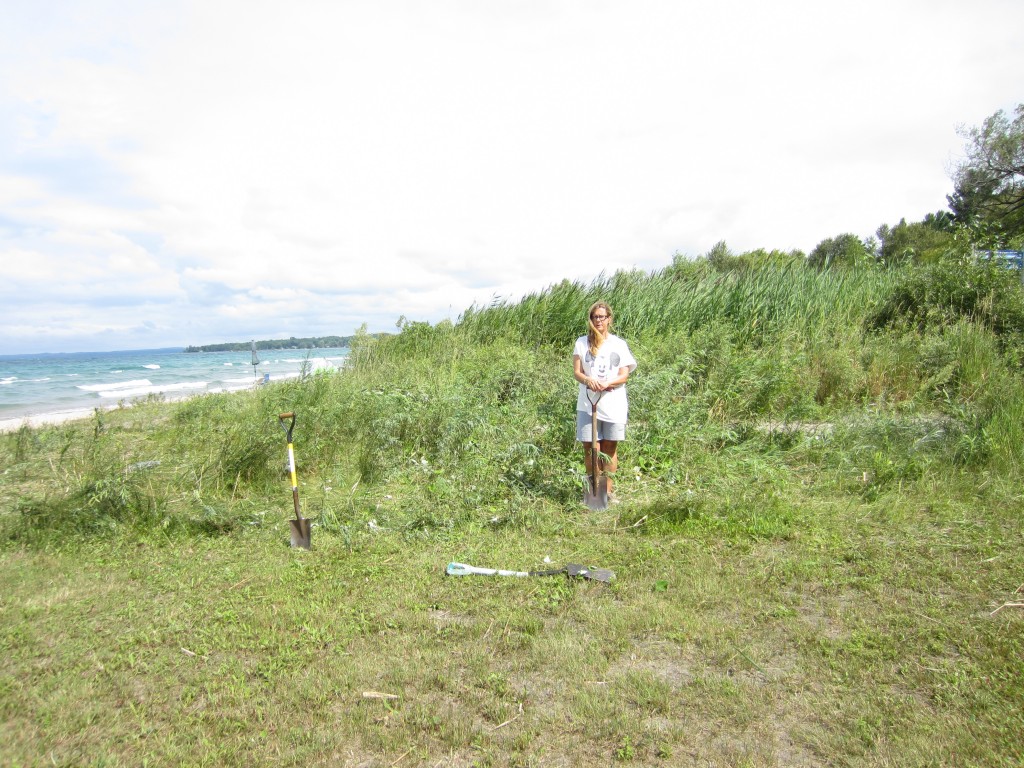
A section of Wymbolwood Beach after non-native Phragmites removal. The large stand of Phragmites in the background is on the Township right-of-way where Phragmites was not controlled. Image courtesy of WBA.
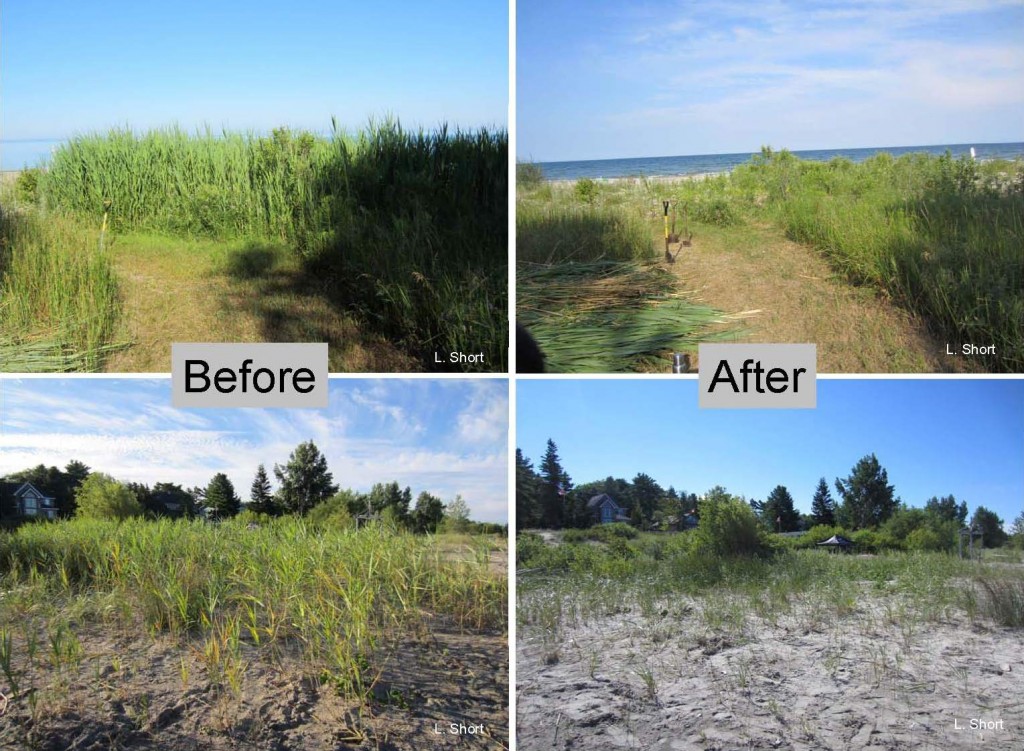
An example of photographs WBA uses to show progress in lieu of formal data collection. Images courtesy of WBA.
